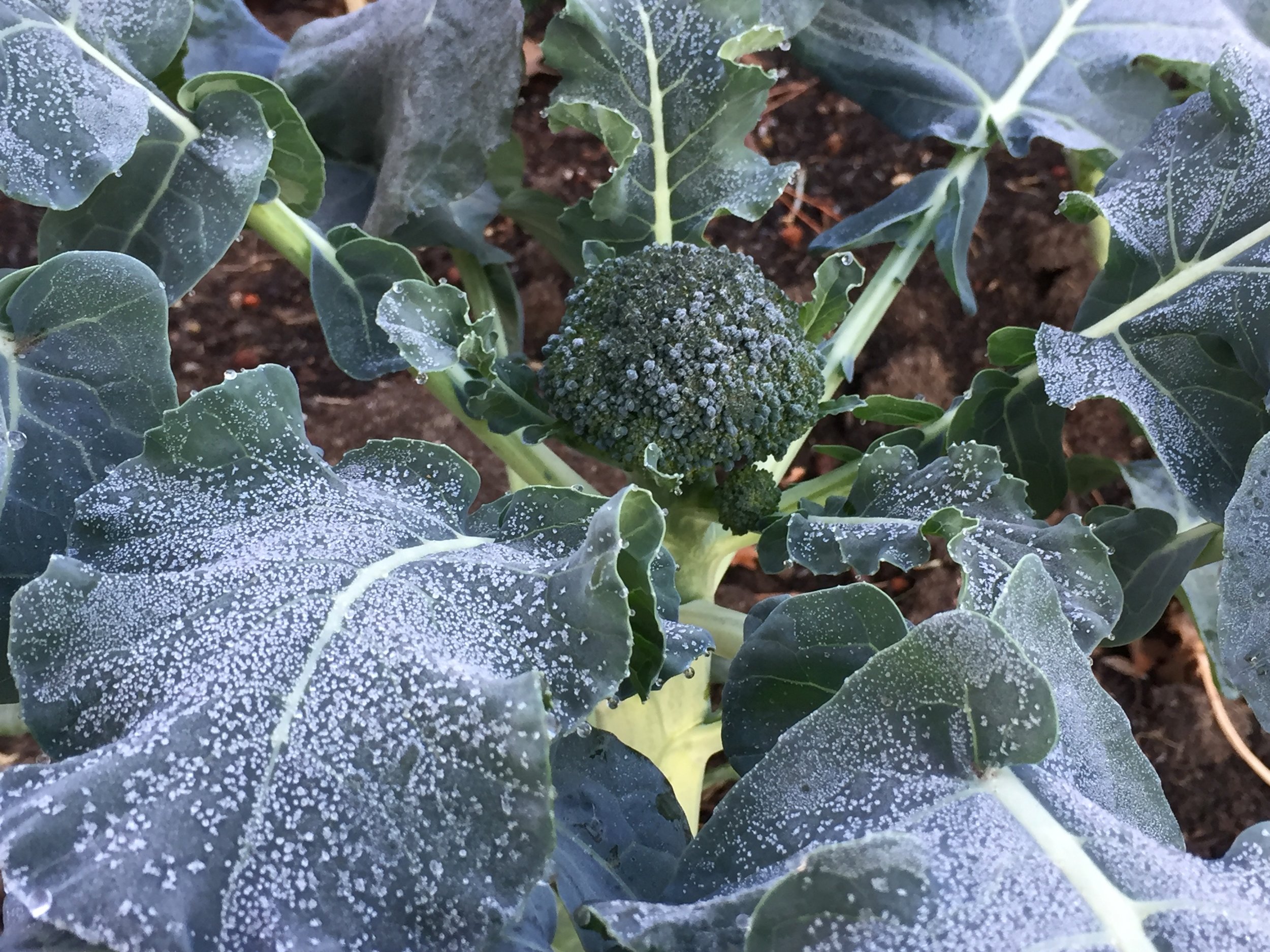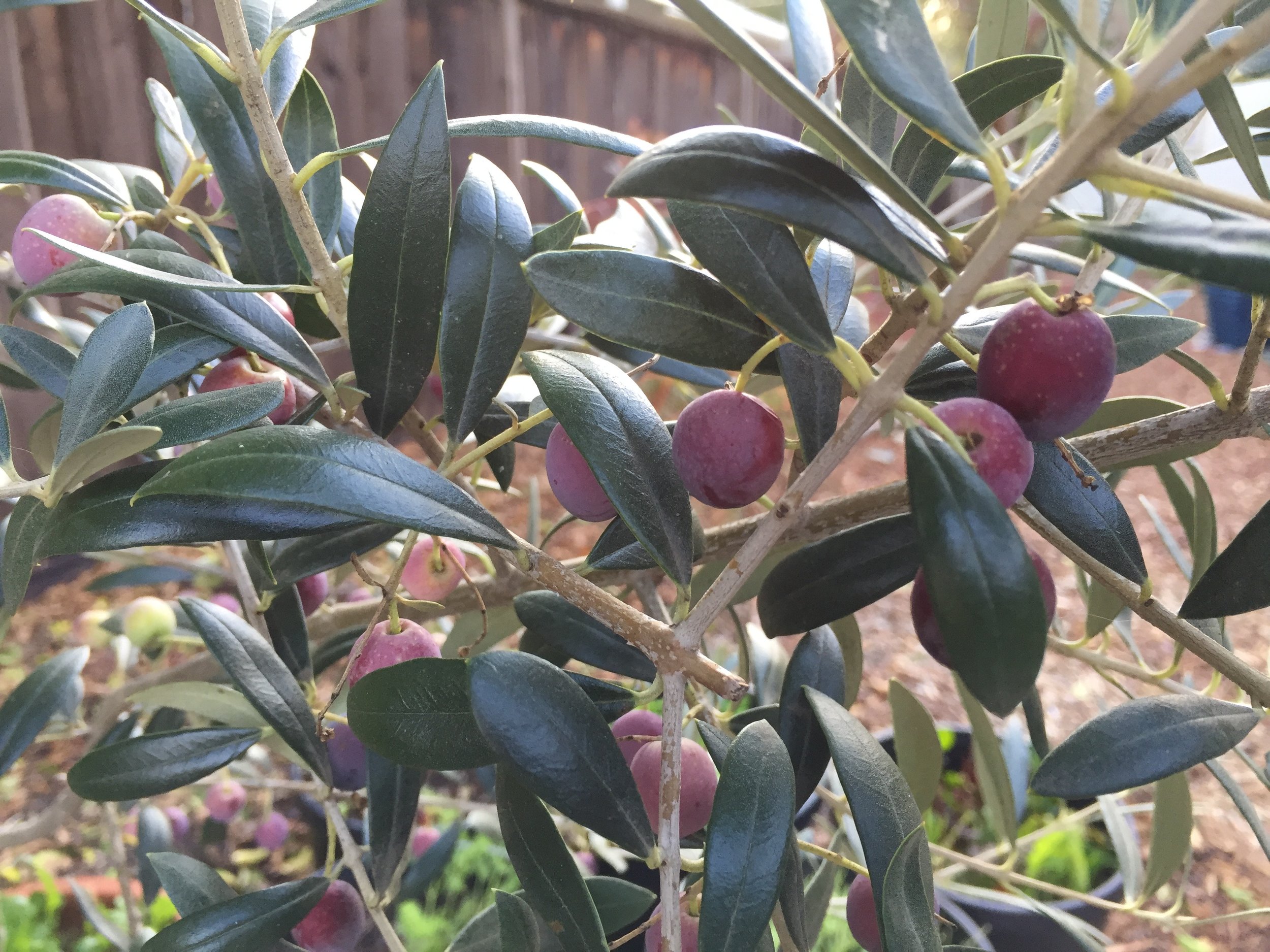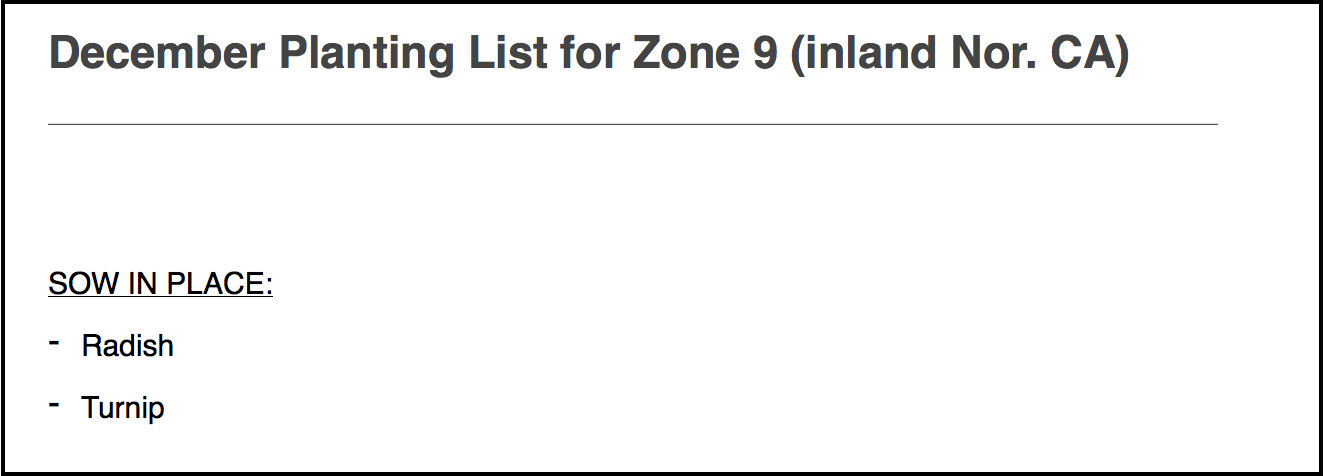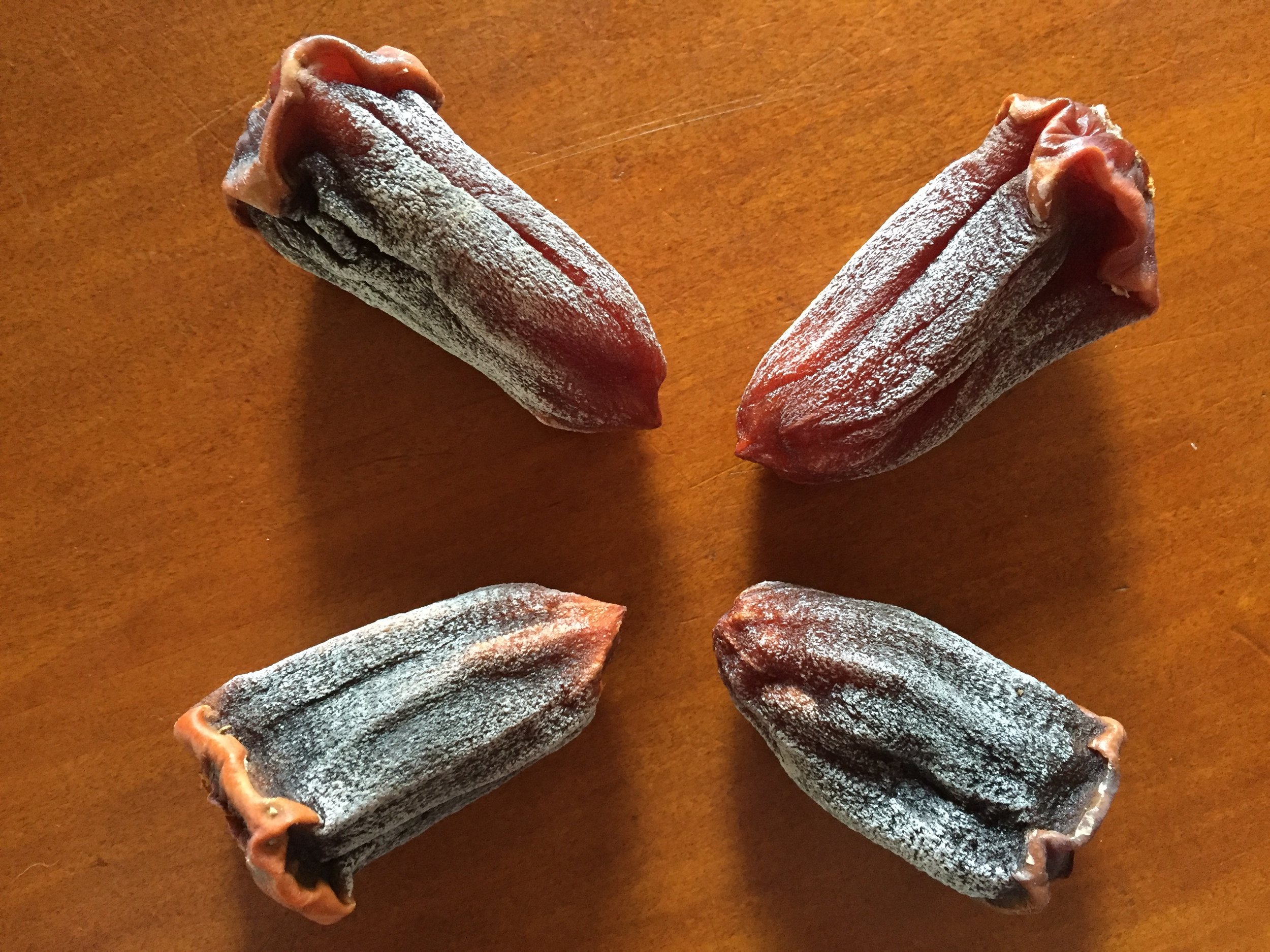It's crunch time at school. The last two weeks of the semester (I've just finished with one of them) contain three finals, one lab practical, two large projects, two presentations, and one book discussion for credit. It's been a bit of a whirlwind. Not a whole lot of time to spend in the garden.
Spinach, with melting frost
However I always try to stop doing homework several times a day and get out to do some sort of yardwork, which I find clears my mind, warms my body, and cheers my spirit. Sometimes I sweep up leaves from the sidewalks and add them to the paths between the beds. Sometimes I turn the compost pile. Sometimes I haul water from the rain barrel to the container plants. I find these breaks very necessary.
8 am, 32 degrees, and the bees are already working - astounding. So much for that old adage about them staying at home unless it's 50 degrees or above.
We've had lovely frosty mornings, but zero rainfall. We've had to run the drip system but I don't like to. The more I learn about what's in our municipal water (which has been added for good reasons), the more I learn it's bad for the garden. More on that in another post. I have to be in the right frame of mind to tackle that one. I must say, the news from my Soil class has been more depressing than hopeful of late.
This cabbage is so beautiful, with it's deckle edge of purple.
I've been removing the summer annual flowers as they get burned up by frost - it's hard to say goodbye to the bright colors of the zinnias, the lacy foliage of the cosmos, and the cheerful orange-red of the tithonia. I'm sure the bees and hummingbirds will miss them too. I retrieved the hummingbird feeder from its summer storage, cleaned it and filled it with sugar syrup. It's hung in its usual place in the Chinese pistache tree right outside the kitchen window for optimal viewing. My tiny friends haven't discovered it just yet, but I know it will soon be a hub of activity. The hummingbirds are often the first birds awake in the morning, getting their bodies moving in the cold. Did you know hummingbirds lower their body temperatures at night so they can survive the low temperatures? We can thank my friend Barbara, birder extraordinaire, for that tidbit of information. It's good to know things, don't you agree?
Shallots in the foreground, wheat in the background.
It's rather freeing to be gardening without the row covers this year, but it also produces a bit of anxiety about how the crops are doing. As you can see from these pictures, everything growing at the moment is placed here because it can withstand cool temperatures. All these crops actually need or improve with a little bit of cold. The only thing that's on the edge is the wheat.
Artichoke
It's winter wheat, so it's meant to be grown now, so I think it'll be ok. It's just a new crop for me. And, as I've said previously, if it does die, at least it will be a green manure for the beds. But I sure would like a small yield for my sourdough baking.
This is how the chickens look in the morning before the sun hits their yard: Hunkered down and fluffed up to stay warm.
I'm a little disappointed in my clover germination rate, and have ordered more to spread around all of the bedded plants, but it probably won't do much at this point, until it warms up a bit. I really need that nitrogen source for the beds. Next winter I might just plant all the beds to clover or vetch over the winter, in order to further improve the soil.
Narcissus blooming already!
Speaking of improving the soil, I've ordered a quarter pound of lupine to scatter in the pollinator beds, along with the usual poppies and other California natives. I realize I haven't done much to enrich the soil in those beds, other than random handfuls of compost over the years. The lupine, being a legume, should help introduce some nitrogen into those areas. As I clear out the summer annuals, I'll add the spring wildflower seeds to compost and scatter them in place, so that as soon as the weather warms up in January, they can get started growing.
Arbequina olives, getting closer to harvest. These two trees are in very large pots, but I'm planning on transplanting them into a space where a privet has been. The privet is now a 15-ft tall tree, and is terribly good at reseeding itself, blech. The only reason I've left it so long is for the bees - they love the flowers. But it's time to remove it. And the olives will be happier in the ground, though they will need excellent drainage.
I'm actually rather unhappy with the lack of bed space for greens, though I planned it to be this way. All the greens are in containers, and they are doing fine, but I'm not getting the harvests that I usually do. I'd have to plant a zillion containers to equal the size of one 4x8 bed. I miss having overflowing baskets of chard, spinach, and kale. I have to be conservative with my use, which bothers me. This is greens season. We should be profligate with their use, eating them at every meal, getting all those good winter nutrients. Instead I am rationing them.
shelling peas
So I'm not sure how to handle this. This is the problem with a small farm. You need time for the cover crops because the soil needs the rejuvenation. But that means there is less space for actual crops. If I had an acre, I could trade off half each season and have room for both. Somehow I am going to have to figure out how to incorporate both covers and crops into the same beds at the same time. Actually this would be good for many reasons. I just have to change my mind about how the beds are supposed to look and work. I have to be creative in my planting schemes.
Some flowers are not minding the cold - the yellow is Rudbeckia hirta and the purple is Felicia echinata.
I think it's important to have an overarching goal for each gardening year. 2017 was our year of tomatoes: Our goal was to simply have more of those, both for fresh eating and for canning. And it worked! Usually we are out of canned tomatoes by about this time of the year. But I still have many jars of both tomatoes and tomato products on the canning shelf and in the freezer. This really feels good. We set a goal, and we accomplished it.
Brussels sprouts, recovering after something ate them
So I think the goal for 2018 is to focus on the soil. Make more and better compost. If I must purchase it, buy the best stuff I can find (more on that later). Don't skimp. Find ways to incorporate living green manures in with my annual crop systems. Continue to utilize chicken manure from our own hens, but also continue to find other sources of clean manure (without any chemicals from antibiotics or other). Know sources. Try to provide as much from my own property as possible. Resource what I have here for best use. Make connections with my neighbors for more resources that might be going to the landfill.
Garlic. This is one of the beds where the clover just didn't germinate. Some rain would be helpful in this regard. I'll try again. This is an ideal crop to have intercropped with another species, as garlic doesn't take up much lateral space.
'Better Soil' is actually a pretty large goal, and is one that can't be accomplished in just a year. And in fact it's been part of all we do here, and have done, for many years now; you've come along with me as I've learned best practices and tried to improve our soil all over the garden, whether it's for vegetables, fruit trees, or perennial ornamentals. But if I make it the primary goal, I think much more will be accomplished much more quickly, because everything I do will be to accomplish that goal first.
These trays of beets, romaine, and carrot starts have been on a table outside under the shelter of a tree. They are doing fine with the frosts.
Some of my practices will have to change. I think I will do less direct sowing in the garden, and instead make use of our little homemade greenhouse for lots of seed starting this winter, so I can put starts in the beds. This means that it will be easier to keep things growing all the time in each bed. There will always be cover; there will never be a time when the beds are bare. For instance, I have a bed where I left Thai basil growing and flowering in half of it, but it is now dead from frost. So I'll take some of these starts I have and replace the basil with them. The other half of the bed has fully grown cauliflower plants, which succeeded pepper plants. I certainly couldn't direct-seed into that basil half of the bed now - well, maybe turnips or radishes - but it would be hard to germinate anything else in there at the moment. However I can transplant these starts in, and they should do just fine.
Ajania pacifica, or Pacific Chrysanthemum, a welcome winter bloomer in a protected space
I'm excited to take you along with me as I work on this goal, and to see how much I can accomplish in one year. I'd also love to hear what YOUR goals are. Plus, has anyone started buying tomato seeds yet? I'm getting all the catalogs, and starting to make a list of all the new ones I want to try. Chime in on your favorites, please, and together maybe we can figure out the ultimate tomato list.
Have a wonderful weekend, everyone.




























